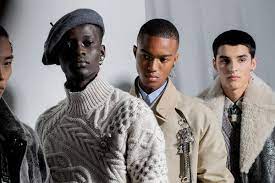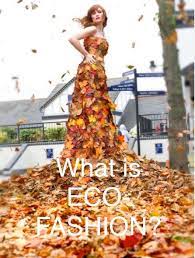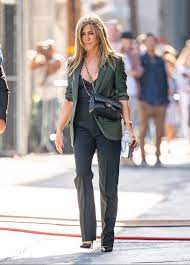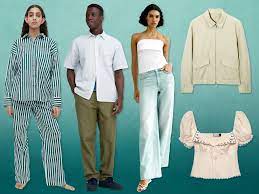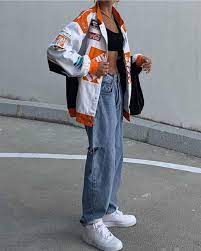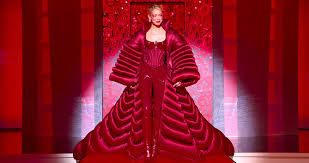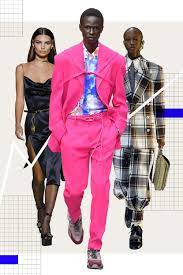Fashion: A Reflection of Personal Style and Expression
Fashion has always been a powerful means of self-expression, allowing individuals to showcase their unique style and personality. It is an ever-evolving art form that transcends boundaries, cultures, and time. From the iconic fashion houses of Paris to the vibrant streets of Tokyo, fashion is a universal language that speaks volumes about who we are.
One of the most remarkable aspects of fashion is its ability to adapt and reflect the changing world around us. It serves as a mirror to society, capturing the zeitgeist of each era. Whether it’s the flapper dresses of the 1920s or the grunge-inspired looks of the 1990s, fashion has consistently mirrored cultural shifts and societal attitudes.
Beyond being a mere trend or fleeting fascination, fashion holds immense power in shaping our confidence and self-perception. The right outfit can boost our mood, enhance our self-esteem, and make us feel ready to conquer any challenge that comes our way. It allows us to express our individuality and creativity without uttering a single word.
Fashion also plays a significant role in creating communities and fostering connections. It brings people together through shared interests and passions. From attending fashion shows to browsing online boutiques, we connect with like-minded individuals who appreciate similar styles or designers. Fashion has an incredible ability to unite people from diverse backgrounds under one common love for aesthetics.
Moreover, fashion empowers us by providing an outlet for experimentation and reinvention. We can transform ourselves through clothing choices – from classic elegance to bold avant-garde statements – allowing us to explore different facets of our personalities. Fashion encourages us to step outside our comfort zones, embrace change, and continually evolve.
In recent years, there has been a growing movement towards sustainable fashion – an acknowledgment that our choices have consequences for both people and the planet. Many designers are now prioritizing ethical practices by using eco-friendly materials, supporting fair trade, and promoting responsible manufacturing processes. This shift towards sustainability highlights the potential of fashion to create positive change and contribute to a more conscious and compassionate world.
Ultimately, fashion is more than just clothes; it is a form of art that enables us to express ourselves, connect with others, and shape our identities. It is a powerful tool that allows us to celebrate our individuality while embracing the collective beauty of diversity. So, whether you prefer timeless classics or cutting-edge trends, let fashion be your canvas and your voice in this ever-evolving world.
7 Advantages of Fashion: Enhancing Self-Expression, Confidence, and Social Connections
- It can be a form of self-expression and creativity.
- It can help to boost confidence and self-esteem.
- It allows you to experiment with different styles and trends.
- It’s an easy way to update your look without spending too much money or time on it.
- Fashion is constantly changing, so it’s always exciting to keep up with the latest trends and styles.
- Wearing fashionable clothes can make you feel more attractive and stylish in social situations as well as in the workplace or other professional settings.
- Fashion helps people connect with others who share similar tastes or interests in style and clothing choices
7 Drawbacks of Fashion: A Critical Analysis of the Industry
- It can be expensive to keep up with the latest trends.
- Fast fashion can have a negative environmental impact due to the production process and materials used.
- Wearing certain clothing items can lead to body image issues and low self-esteem.
- Following trends blindly can lead to a lack of individual style and personality in one’s wardrobe choices.
- There is often a lack of diversity in fashion, particularly when it comes to size and gender identity inclusion on the catwalk or in magazines/adverts etc..
- Some fabrics used for clothing are not always ethically sourced or produced, leading to exploitation of workers in poorer countries for example.
- Pressure from social media platforms such as Instagram, YouTube or TikTok can create unrealistic expectations about what people should look like or wear which is damaging for many people’s mental health and wellbeing
Fashion: Unleashing Self-Expression and Creativity
Fashion has long been celebrated as a powerful form of self-expression and a canvas for creativity. It allows individuals to showcase their unique personality, style, and artistic flair to the world. From choosing the perfect outfit to experimenting with different combinations and accessories, fashion offers endless possibilities for self-discovery and self-representation.
One of the most incredible aspects of fashion is its ability to empower individuals to communicate who they are without uttering a single word. The clothes we wear can convey our mood, interests, and values. Whether it’s a vibrant patterned dress that exudes confidence or a minimalist ensemble that reflects understated elegance, fashion enables us to express ourselves authentically.
Moreover, fashion encourages us to tap into our creativity and explore new horizons. It challenges us to think outside the box, experiment with colors, textures, and silhouettes, and push boundaries. Fashion designers are like artists who use fabric as their medium, creating wearable masterpieces that inspire awe and admiration.
Fashion also fosters a sense of community by connecting individuals who share similar tastes and passions. It creates spaces where people can come together – from fashion shows to online forums – to exchange ideas, seek inspiration, and celebrate each other’s unique styles. This sense of belonging fuels further creativity as we draw inspiration from others while infusing our own personal touch.
In recent years, social media has played a significant role in democratizing fashion expression. Platforms like Instagram have become virtual runways where people can curate their own personal style narratives and gain recognition for their creativity. This digital landscape has opened doors for aspiring fashion enthusiasts worldwide, allowing them to showcase their unique perspectives on style without traditional barriers.
Furthermore, fashion’s ability to be inclusive knows no bounds. Regardless of age, gender identity or body shape, everyone can find their place in the world of fashion. It celebrates diversity by offering an array of options that cater to various tastes and preferences. Fashion is a realm where individuality is celebrated, and everyone can find their own voice.
In essence, fashion serves as a powerful vehicle for self-expression and creativity. It allows us to embrace our uniqueness, celebrate our individuality, and connect with others who share our passion for style. So let your wardrobe be a reflection of your inner self, an outlet for your creativity, and an invitation to the world to witness the beautiful tapestry of your personal expression.
It can help to boost confidence and self-esteem.
Fashion: Boosting Confidence and Self-Esteem
Fashion has an incredible power to boost confidence and enhance self-esteem. The clothes we wear can have a profound impact on how we feel about ourselves and how others perceive us. It’s not just about following trends or looking stylish; it’s about finding the right pieces that make us feel confident, comfortable, and true to ourselves.
When we put on an outfit that we love, it can instantly uplift our mood and transform our mindset. The right combination of colors, textures, and styles can make us feel like the best version of ourselves. It’s like wearing a suit of armor that shields us from self-doubt and empowers us to face the world with a renewed sense of self-assurance.
Fashion allows us to express our individuality and personality through our clothing choices. It gives us the freedom to experiment with different styles, mix and match patterns, or create unique ensembles that reflect who we are. When we dress in a way that aligns with our personal taste, it sends a powerful message to ourselves and others – that we have the confidence to embrace our own unique style.
Moreover, fashion provides an opportunity for self-care and self-expression. Taking the time to select outfits that make us feel good can be a form of self-love. It’s about prioritizing our own well-being by choosing clothes that flatter our body shape, highlight our best features, and make us feel comfortable in our own skin.
Fashion also plays a significant role in how others perceive us. When we dress confidently, it radiates from within and leaves a lasting impression on those around us. People respond positively to someone who exudes self-assurance through their style choices. This positive feedback further boosts our confidence and reinforces our belief in ourselves.
It is important to note that fashion should not be solely focused on external appearance or conforming to societal standards. True confidence comes from within, and fashion should be a tool that helps us express our authentic selves. It is about embracing our unique qualities, celebrating diversity, and feeling comfortable in our own skin.
So, the next time you reach into your wardrobe, remember that fashion has the power to uplift your spirits and boost your confidence. Choose clothes that make you feel like the best version of yourself, embrace your individuality, and let your style be a reflection of your inner strength. Fashion is not just about what you wear; it’s about how it makes you feel.
It allows you to experiment with different styles and trends.
Fashion: Embrace the Art of Experimentation
One of the greatest advantages of fashion is its ability to let us explore and experiment with different styles and trends. It serves as a creative outlet, allowing us to step outside our comfort zones and discover new facets of our personal style.
Fashion is an ever-evolving art form, constantly presenting us with fresh ideas, innovative designs, and exciting trends. It provides a platform for self-expression, enabling us to curate our own unique looks by blending various elements and influences. Whether it’s mixing vintage pieces with modern accessories or combining high-end fashion with high-street finds, fashion empowers us to create something truly individual.
By experimenting with different styles and trends, we can break free from the confines of routine and embrace a sense of adventure. It opens up endless possibilities for self-discovery, allowing us to tap into our creativity and challenge societal norms. We can use fashion as a tool to redefine ourselves, expressing different sides of our personality through clothing choices.
Moreover, experimenting with fashion also allows us to stay current and relevant in an ever-changing world. By keeping an eye on emerging trends, we can adapt our style to reflect the times while still staying true to ourselves. Fashion gives us the freedom to play with new colours, patterns, textures, and silhouettes – transforming our appearance in exciting ways.
The beauty of fashion experimentation lies in its lack of boundaries or rules. There are no right or wrong choices when it comes to personal style; it’s all about what makes you feel confident and comfortable. Whether you want to channel your inner bohemian spirit one day or embrace a sleek minimalist look the next, fashion grants you the opportunity to explore diverse aesthetics without limitations.
In addition to personal growth and expression, experimenting with different styles can also inspire others around you. Your bold choices might encourage someone else to step out of their comfort zone or discover their own unique sense of style. Fashion has the power to spark conversations, connect people, and build communities based on shared interests and admiration for creativity.
So, embrace the art of experimentation and let fashion be your playground. Explore different styles, mix and match various trends, and discover what truly resonates with you. Allow fashion to be a reflection of your ever-evolving self, a canvas upon which you can express your individuality. Remember, in the world of fashion, there are no limits – only endless possibilities waiting to be explored.
It’s an easy way to update your look without spending too much money or time on it.
Fashion: The Budget-Friendly Route to a Fresh Look
In a world that constantly evolves, fashion offers us an easy and accessible way to update our look without breaking the bank or investing excessive time. It’s like a breath of fresh air for our style, allowing us to effortlessly stay on-trend and express our individuality.
One of the greatest advantages of fashion is its ability to transform our appearance without requiring substantial financial investments. Unlike major home renovations or expensive hobbies, updating one’s wardrobe can be done on a budget. With a keen eye for sales, discounts, and thrift stores, it’s possible to find stylish pieces at affordable prices.
Fashion also allows us to get creative with our existing wardrobe. By mixing and matching different items, experimenting with accessories, or trying new combinations, we can revitalize our outfits without spending a penny. Sometimes all it takes is a fresh perspective or an unexpected pairing to breathe new life into old favorites.
Moreover, fashion enables us to stay in tune with current trends without dedicating excessive time to research or shopping sprees. By following fashion influencers online or flipping through magazines, we can easily identify the latest styles and incorporate them into our own wardrobes. Whether it’s adding a trendy accessory or embracing a new color palette, these small updates keep us feeling fashionable and relevant.
Fashion also encourages us to think outside the box when it comes to personal style. Instead of feeling restricted by societal norms or expectations, we can use fashion as an opportunity for self-expression and experimentation. It allows us to explore different aesthetics and try out diverse looks until we find what truly resonates with our personality.
In essence, fashion provides an accessible avenue for updating our look without draining our wallets or consuming excessive amounts of time. It offers endless possibilities for creativity and self-expression while keeping us in touch with current trends. So next time you want to refresh your style without breaking the bank, turn to fashion as your trusted ally. With a little imagination and resourcefulness, you can effortlessly reinvent your look and embrace a new chapter of personal style.
Fashion is constantly changing, so it’s always exciting to keep up with the latest trends and styles.
Fashion: Embracing the Thrill of Change
One of the most thrilling aspects of fashion is its ever-changing nature. It keeps us on our toes, constantly evolving and presenting new trends and styles to explore. This dynamic quality of fashion brings excitement, creativity, and a sense of anticipation into our lives.
The constant evolution of fashion ensures that we are never stuck in a style rut. It encourages us to step out of our comfort zones and experiment with different looks. Whether it’s trying out a bold new pattern, incorporating vibrant colours, or embracing unique silhouettes, fashion allows us to express ourselves in fresh and exciting ways.
Keeping up with the latest trends also gives us a sense of being part of something bigger. It connects us to a global community that shares a passion for style and self-expression. From fashion magazines to social media platforms, there are countless sources that provide inspiration and keep us informed about the latest fashion movements.
The ever-changing nature of fashion also provides an opportunity for personal growth and self-discovery. As we explore new trends and styles, we learn more about ourselves – what we like, what makes us feel confident, and what resonates with our individuality. Fashion becomes a tool for self-exploration, allowing us to curate our own unique identity through clothing choices.
Moreover, staying updated with the latest trends can enhance our social interactions. It sparks conversations among friends, colleagues, and even strangers who share an interest in fashion. The exchange of ideas and opinions creates a sense of community while broadening our perspectives on style.
However, it’s important to remember that while keeping up with trends can be exciting, it’s equally important to stay true to ourselves. Fashion should be seen as an opportunity for self-expression rather than something that dictates who we should be or how we should look. Embracing personal style means finding a balance between staying current with trends and staying authentic to our own preferences and values.
So, let’s embrace the thrill of change that fashion brings. Let’s enjoy the excitement of discovering new trends, experimenting with different styles, and expressing our individuality through our clothing choices. Fashion is a never-ending journey of self-discovery, and by staying open to change, we can continuously evolve and find joy in the ever-evolving world of style.
Wearing fashionable clothes can make you feel more attractive and stylish in social situations as well as in the workplace or other professional settings.
The Power of Fashion: Boosting Confidence and Style in Social and Professional Settings
Fashion has an incredible ability to transform how we feel about ourselves, particularly in social and professional settings. When we wear fashionable clothes that make us feel attractive and stylish, our confidence soars, and we exude a certain charisma that can leave a lasting impression on others.
In social situations, dressing fashionably allows us to express our personal style and stand out from the crowd. Whether it’s a casual gathering or a formal event, wearing clothes that make us feel confident can have a significant impact on our interactions with others. When we feel good about how we look, it radiates through our body language and demeanor, making us more approachable and engaging.
In the workplace or other professional settings, fashion plays an equally important role. Dressing appropriately and stylishly can help us command respect while showcasing our professionalism. It sends a message that we take pride in our appearance and are serious about what we do. This can lead to increased opportunities for advancement, as well as positive perceptions from colleagues and superiors.
Moreover, fashionable attire can also boost our own self-perception. When we dress well, it instills a sense of self-assurance that transcends outward appearances. It reminds us of our capabilities and strengths, allowing us to tackle challenges with greater confidence. The way we present ourselves through fashion becomes an extension of our personality – an outward reflection of the inner qualities that make us unique.
Fashion is not just about following trends; it is about finding clothing that resonates with our individuality. It is about understanding what makes us feel comfortable, empowered, and authentic. By embracing fashion as a tool for self-expression, we can harness its power to enhance not only our external appearance but also our internal confidence.
So next time you find yourself standing in front of your wardrobe unsure of what to wear, remember the transformative power of fashion. Choose clothes that make you feel attractive and stylish, and watch as your confidence soars. Whether it’s a social gathering or a professional setting, let fashion be your ally in leaving a lasting impression and embracing the best version of yourself.
Fashion helps people connect with others who share similar tastes or interests in style and clothing choices
Fashion: A Gateway to Connection and Community
In a world that often feels disconnected, fashion serves as a bridge that brings like-minded individuals together. It acts as a common language, allowing people to connect with others who share similar tastes and interests in style and clothing choices.
Fashion has the remarkable ability to create communities and foster connections. Whether it’s attending fashion events, joining online forums, or simply striking up conversations with strangers who appreciate your outfit, fashion provides an avenue for building relationships based on shared aesthetics.
When we encounter someone dressed in a way that resonates with our own personal style, there is an instant recognition and appreciation. It sparks conversations, initiates friendships, and forms bonds that go beyond mere surface-level interactions. Fashion becomes the starting point for deeper connections and meaningful relationships.
Through fashion, we find ourselves surrounded by individuals who understand our passion for self-expression through clothing. These connections go beyond geographical boundaries or cultural differences; they are built on a shared love for aesthetics and personal style.
Fashion communities provide platforms for dialogue, inspiration, and support. They offer spaces where individuals can exchange ideas, seek advice, and celebrate each other’s unique approaches to fashion. Whether it’s discussing the latest trends or discovering new brands together, these communities foster a sense of belonging and camaraderie.
Moreover, connecting with others who share similar tastes in fashion can be empowering. It reaffirms our choices and boosts our confidence when we see others embracing similar styles or taking risks with their outfits. Fashion communities become safe spaces where we feel accepted and encouraged to express ourselves authentically.
In today’s digital age, social media platforms have played a significant role in expanding these connections even further. Fashion influencers and bloggers have created virtual communities where people can come together to discuss their favorite styles, seek inspiration from one another, or even collaborate on creative projects.
Fashion’s ability to connect people goes beyond superficial judgments; it celebrates individuality while simultaneously fostering a sense of unity. It reminds us that despite our diverse backgrounds and experiences, we can find common ground through our shared passion for self-expression.
So, the next time you spot someone sporting an outfit that catches your eye, don’t hesitate to strike up a conversation. Fashion has the power to bring people together, forge lasting connections, and create a sense of belonging in a world that often feels disconnected. Embrace the opportunities it offers to connect with others who share your love for style and clothing choices – you never know what incredible connections may await you.
It can be expensive to keep up with the latest trends.
The Costly Pursuit: The Expense of Keeping Up with Fashion Trends
Fashion trends come and go, and for many style enthusiasts, keeping up with the latest must-haves can be an exciting but expensive endeavor. While fashion allows us to express our individuality and stay in tune with the ever-evolving world of style, it’s essential to acknowledge the financial implications that can arise from this pursuit.
One of the significant drawbacks of fashion is its price tag. As trends change rapidly, so do the garments and accessories required to stay on-trend. From designer labels to high-street brands, keeping up with fashion’s ever-changing landscape often means investing in new pieces regularly. This constant need for new items can strain our wallets and lead to a constant cycle of spending.
Moreover, the pressure to keep up with trends can create a sense of dissatisfaction with our existing wardrobe. The desire for novelty may overshadow the appreciation for timeless pieces that withstand passing fads. This mindset encourages a throwaway culture where clothes are discarded after minimal use, contributing to environmental concerns such as textile waste and carbon emissions.
It’s crucial to find a balance between embracing new trends and being mindful of our financial well-being. Here are a few strategies that can help navigate this conundrum:
- Invest in timeless staples: Prioritize classic pieces that transcend trends and can be styled in various ways. These versatile items will serve as a solid foundation for your wardrobe while minimizing the need for frequent replacements.
- Thrift shopping: Explore second-hand stores or online platforms where you can find unique, pre-loved items at more affordable prices. Not only will you discover hidden gems, but you’ll also contribute to sustainable fashion practices by giving clothing a second life.
- Rent or borrow: Consider renting special occasion outfits or subscribing to clothing rental services for temporary fashion fixes without committing to long-term ownership.
- DIY and customization: Get creative by upcycling or customizing your existing pieces to give them a fresh, trendy twist. This way, you can breathe new life into your wardrobe without breaking the bank.
Remember, fashion is about personal style and self-expression, and it should never be a burden on your finances. By being mindful of our spending habits and exploring alternative options, we can enjoy fashion without compromising our financial well-being. Embrace the joy of mixing and matching, experiment with your existing wardrobe, and let your unique sense of style shine through – regardless of the latest trends.
Fast fashion can have a negative environmental impact due to the production process and materials used.
Fast Fashion: The Hidden Environmental Consequences
In our fast-paced world, where trends change at the blink of an eye, fast fashion has become a dominant force in the industry. With its promise of affordable and constantly updated styles, it has captured the attention of consumers worldwide. However, behind this seemingly glamorous facade lies a dark truth – the negative environmental impact caused by the production process and materials used in fast fashion.
The production cycle of fast fashion is characterized by rapid turnover and high volume. This leads to immense pressure on manufacturers to produce garments quickly and cheaply, often resulting in unethical labor practices and exploitation of workers. The demand for low-cost clothing often leads to sweatshop conditions, where workers are subjected to long hours, low wages, and hazardous working environments.
Furthermore, the materials used in fast fashion are often synthetic fibers derived from non-renewable resources such as petroleum. These materials have a significant carbon footprint and contribute to greenhouse gas emissions during their production process. Additionally, the use of toxic chemicals in dyeing and finishing processes further pollutes waterways and harms ecosystems.
Another concerning aspect is the disposal of fast fashion items. Due to their low-quality construction and short lifespan, these garments are frequently discarded after only a few wears. The sheer volume of clothing waste generated by fast fashion contributes to overflowing landfills and incineration practices that release harmful pollutants into the air.
Fortunately, awareness about these environmental consequences is growing, leading to a rise in sustainable fashion movements. Many consumers are now opting for eco-friendly alternatives like organic cotton or recycled materials. Additionally, there is a push towards repairing, upcycling, or donating clothes instead of disposing of them.
Fashion brands are also taking steps towards sustainability by implementing responsible manufacturing practices. They are adopting circular economy models that focus on reducing waste through recycling or repurposing garments.
As consumers, we have the power to make a difference by making conscious choices about what we wear. By supporting ethical and sustainable fashion brands, we can contribute to reducing the negative environmental impact of fast fashion. We can also extend the lifespan of our clothing by embracing a more mindful approach to consumption, opting for quality over quantity.
In conclusion, while fast fashion may offer immediate gratification and affordability, it comes at a significant environmental cost. By understanding these consequences and making informed choices, we can protect our planet and promote a more sustainable future for the fashion industry. Together, we can redefine the way we consume fashion and create a positive impact on both the environment and society as a whole.
Wearing certain clothing items can lead to body image issues and low self-esteem.
The Dark Side of Fashion: Body Image Issues and Low Self-Esteem
While fashion is often celebrated for its ability to empower and uplift, it is essential to acknowledge the negative impact it can have on individuals’ body image and self-esteem. In today’s society, there is immense pressure to conform to certain beauty standards perpetuated by the fashion industry, leading many to develop unhealthy relationships with their bodies.
One of the main culprits behind this con of fashion is the unrealistic portrayal of body types. The prevalence of ultra-thin models on runways and in advertisements can create an unattainable ideal that many people feel compelled to strive for. This constant exposure to images of “perfect” bodies can breed feelings of inadequacy and dissatisfaction with one’s own appearance.
Moreover, certain clothing items are designed with specific body shapes in mind, leaving those who do not fit within these narrow parameters feeling excluded or inadequate. This exclusionary approach can be disheartening and contribute to a negative self-image.
Furthermore, the constant pressure to keep up with ever-changing fashion trends can lead individuals to compare themselves unfavourably with others. The fear of being judged or ridiculed for not conforming to societal expectations can take a toll on one’s confidence and self-esteem.
It is crucial for both the fashion industry and society as a whole to recognize the harmful effects these standards can have on individuals’ mental well-being. Embracing diversity in body types and promoting inclusivity should be at the forefront of fashion discourse. By showcasing a wide range of body sizes, shapes, ages, and abilities, we can foster a healthier environment that celebrates individuality rather than conformity.
Additionally, promoting positive body image through campaigns that emphasize self-acceptance, self-love, and diversity can help counteract the negative impact of unrealistic beauty standards. Encouraging brands to offer a broader range of sizes and styles will also ensure that everyone has access to fashionable clothing that makes them feel confident and comfortable.
Ultimately, it is essential for individuals to remember that fashion should be a tool for self-expression and not a means of defining one’s worth. Embracing our unique bodies and celebrating our individuality is far more important than conforming to society’s narrow standards. By promoting inclusivity, diversity, and self-acceptance within the fashion industry, we can create a more positive and empowering environment for all.
Following trends blindly can lead to a lack of individual style and personality in one’s wardrobe choices.
Following Trends Blindly: The Loss of Individuality in Fashion Choices
In the fast-paced world of fashion, trends come and go with lightning speed. From the catwalks to social media influencers, we are constantly bombarded with new styles and must-have items. While it can be exciting to stay up-to-date with the latest fashion trends, blindly following them can sometimes lead to a loss of individual style and personality in our wardrobe choices.
One of the most beautiful aspects of fashion is its ability to reflect our unique personalities and express our individuality. Our clothing choices allow us to showcase our personal style, preferences, and values. However, when we become too fixated on following trends without considering our own tastes and preferences, we risk losing that sense of authenticity.
By mindlessly adopting every passing trend, we risk blending into a sea of sameness. It becomes difficult for others to distinguish our personal style amidst a crowd all wearing the same popular items. Our outfits may lack a sense of originality and fail to truly represent who we are as individuals.
Moreover, blindly following trends can also lead to unnecessary spending and waste. Fashion trends often change rapidly, rendering yesterday’s “must-haves” obsolete today. This constant cycle can create a never-ending desire for new clothes, resulting in impulse purchases that may not align with our long-term style or wardrobe needs. It contributes to the problem of fast fashion – an industry known for its negative environmental impact.
However, this is not to say that following trends is inherently wrong or should be completely avoided. Trends can inspire us and push us out of our comfort zones by introducing new styles or silhouettes that we may have never considered before. They can serve as a starting point for experimentation and creativity within our personal style.
The key lies in finding a balance between embracing trends and staying true to ourselves. Instead of mindlessly adopting every trend, we can selectively incorporate elements that resonate with our personal style and enhance our individuality. This approach allows us to curate a wardrobe that reflects our unique tastes, preferences, and values.
Ultimately, fashion should be a tool for self-expression rather than a means of conformity. By consciously considering our own style and personality when making fashion choices, we can maintain our individuality while still appreciating the ever-changing trends that inspire us. Let’s celebrate our uniqueness and use fashion as a means to express who we truly are, rather than simply following the crowd.
There is often a lack of diversity in fashion, particularly when it comes to size and gender identity inclusion on the catwalk or in magazines/adverts etc..
The Lack of Diversity in Fashion: A Call for Inclusion and Representation
Fashion has long been hailed as a creative and innovative industry that sets trends and shapes cultural norms. However, one glaring con that continues to persist is the lack of diversity, particularly concerning size and gender identity representation on the catwalks, in magazines, and advertisements.
When we talk about diversity in fashion, it goes beyond mere tokenism or ticking boxes. It is about embracing the beauty and uniqueness of all individuals, regardless of their size or gender identity. Unfortunately, the industry has often perpetuated narrow beauty standards that exclude a significant portion of society.
One aspect where this lack of diversity is evident is in the limited representation of different body sizes. The fashion industry has traditionally celebrated a thin ideal, leaving many individuals feeling marginalized or inadequate. This exclusionary approach not only damages self-esteem but also reinforces harmful stereotypes about body image.
Similarly, there is a significant dearth of gender identity inclusion on the catwalks and in fashion media. The binary notion of male or female clothing restricts self-expression for those who identify beyond these traditional labels. By failing to represent diverse gender identities, fashion inadvertently reinforces societal norms rather than challenging them.
However, it’s important to note that progress is being made. There are inspiring movements within the industry that are pushing for change and demanding inclusivity. More brands are now embracing body positivity by featuring models with diverse sizes on their runways and campaigns. Designers are also challenging gender norms by creating collections that defy traditional expectations.
Moreover, consumers have become increasingly vocal about their desire to see themselves represented in fashion media. Social media platforms have provided a space for marginalized voices to be heard and celebrated. This shift in power has forced brands to listen and respond by diversifying their offerings.
To truly address this con of fashion, it requires collective effort from designers, brands, media outlets, and consumers alike. The industry needs to actively seek out and promote diverse talent, both on the runway and behind the scenes. It’s crucial to challenge existing beauty standards and embrace a broader definition of beauty that celebrates all body types and gender identities.
Furthermore, fashion media should play a pivotal role in normalizing diversity by featuring a wide range of individuals in their publications and advertisements. By doing so, they can inspire people from all walks of life to feel seen, represented, and empowered.
In conclusion, the lack of diversity in fashion regarding size and gender identity is an ongoing issue that needs urgent attention. However, with increasing awareness and a collective commitment to change, we can foster an inclusive industry that celebrates the beauty of every individual. Let us strive for a fashion world where everyone feels welcome, represented, and valued.
Some fabrics used for clothing are not always ethically sourced or produced, leading to exploitation of workers in poorer countries for example.
The Dark Side of Fashion: Unethical Sourcing and Exploitation
While fashion is often celebrated for its creativity and glamour, it is essential to acknowledge the darker side of the industry. Behind the scenes, some fabrics used for clothing are not always ethically sourced or produced, leading to the exploitation of workers in poorer countries.
In our quest for trendy and affordable garments, we may unknowingly support a system that perpetuates unfair labor practices. Many clothing brands outsource their production to countries where labor costs are lower, often resulting in substandard working conditions and meager wages for garment workers. These individuals, predominantly women, toil long hours in factories with little regard for their well-being.
Moreover, the production of certain fabrics involves environmental harm and human rights abuses. For instance, cotton farming can have devastating consequences on local ecosystems due to excessive pesticide use and water pollution. Additionally, there have been reports of child labor being employed in cotton fields in some regions.
The exploitation faced by these workers highlights a pressing need for transparency and accountability within the fashion industry. Consumers play a crucial role in driving change by demanding more ethical practices from brands they support. By choosing to purchase from companies that prioritize fair trade, sustainable sourcing, and responsible manufacturing processes, we can contribute to positive change.
Thankfully, there is a growing awareness surrounding these issues. Many fashion brands are now taking steps towards more ethical sourcing and production methods. They are investing in fair wages for workers, ensuring safe working conditions, and using sustainable materials that minimize harm to both people and the environment.
As consumers, we can make informed choices by researching brands’ ethical practices before making purchases. Supporting initiatives such as fair trade certifications or choosing second-hand clothing can also help reduce our contribution to exploitative practices.
Ultimately, it is crucial that we recognize the impact our fashion choices have on the lives of others. By advocating for transparency and supporting ethical fashion practices, we can work towards a more sustainable and fair industry. Together, we can strive for a future where fashion is not only beautiful but also responsible and compassionate.
The Dark Side of Fashion: Unrealistic Expectations in the Social Media Era
In today’s digital age, social media platforms like Instagram, YouTube, and TikTok have become powerful influencers in the world of fashion. While these platforms offer endless inspiration and creativity, they also come with a downside that can have a detrimental impact on people’s mental health and overall wellbeing.
One of the significant drawbacks of the fashion industry’s presence on social media is the unrealistic expectations it sets for appearance and style. With carefully curated feeds showcasing flawless models, picture-perfect outfits, and seemingly unattainable beauty standards, it’s easy to fall into the trap of comparison and self-doubt.
Constant exposure to these idealized images can create a distorted perception of what is considered “normal” or “beautiful.” It can lead individuals to question their own bodies, feel inadequate, and develop negative body image issues. The pressure to conform to these unrealistic standards can take a toll on mental health and wellbeing.
Moreover, social media platforms often promote fast fashion trends that encourage excessive consumption. The constant bombardment of new styles and must-have items can create a sense of urgency to keep up with ever-changing fashion cycles. This consumerist culture not only puts financial strain on individuals but also contributes to environmental degradation through increased waste and exploitation of resources.
Fortunately, there is growing awareness about these issues within the fashion industry itself. Many influencers, designers, and activists are using their platforms to advocate for body positivity, inclusivity, sustainability, and mental health awareness. They are encouraging people to embrace their unique beauty and personal style while promoting ethical practices within the industry.
As individuals navigating this digital landscape saturated with fashion ideals, it’s crucial to remember that what we see online often represents an edited version of reality. We must remind ourselves that true beauty comes in all shapes, sizes, colours, and styles. It is essential to cultivate self-acceptance and prioritize our mental health over external validation.
Setting boundaries with social media consumption, diversifying our feeds to include a range of body types and styles, and engaging with content that promotes positive messages can help counteract the negative impact of unrealistic fashion expectations. By being mindful consumers and supporting brands that align with our values, we can contribute to a more inclusive and healthy fashion culture.
In conclusion, while social media platforms have undoubtedly revolutionized the fashion industry by providing inspiration and connecting individuals worldwide, it’s important to be aware of the potential negative effects. By challenging unrealistic expectations, embracing diversity, and prioritizing mental wellbeing, we can navigate the world of fashion in a healthier and more empowering way.

